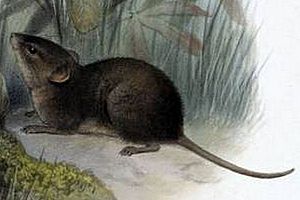Alston's brown mouse facts for kids
Quick facts for kids Alston's brown mouse |
|
|---|---|
 |
|
| Conservation status | |
| Scientific classification | |
| Genus: |
Scotinomys
|
| Species: |
teguina
|
The Alston's brown mouse, also known as the Alston's singing mouse or just singing mouse (Scotinomys teguina), is a small rodent from the Cricetidae family. It lives in Central America, from Chiapas, Mexico, all the way to western Panama.
This special mouse makes sounds that are both loud enough for us to hear (sonic) and too high-pitched for us to hear (ultrasonic). These sounds are very important for how they talk to each other.
Contents
Where does the singing mouse live?
The Alston's singing mouse lives only in the mountain forests of Central America. You can find it from Chiapas, Mexico, down to western Panama. It lives at high places, between 1,100 and 2,950 meters above sea level. Countries where it lives include Costa Rica, El Salvador, Guatemala, Honduras, Mexico, Nicaragua, and Panama.
This mouse likes wet places with a warm, subtropical climate. It is often seen in grassy clearings and rocky spots at the edge of the forest. In the wild, the Alston's singing mouse is active during the day. When studied in labs, it is most active in the morning and less active in the afternoon and evening.
What does the singing mouse look like?
The Alston's singing mouse is quite small, weighing about 10 to 13 grams. It has a dark fur coat and a short tail. Its belly is dark gray-brown to orange-brown. The tail is blackish and has only a few hairs. Its feet are black. This mouse also has a strong, musky smell that you can easily notice.
How does the singing mouse behave?
What does the singing mouse eat?
The Alston's singing mouse mostly eats insects, like beetles and other small bugs. It also eats a small amount of seeds and fruits.
Why does the singing mouse sing?
The Alston's singing mouse is famous for its unique singing. Both male and female mice sing. Their songs have parts that humans can hear (sonic) and parts that are too high-pitched for us to hear (ultrasonic). Male songs are usually longer than female songs, but they sound similar.
While many rodents make ultrasonic sounds, very few sing in such a continuous and clear way as the Alston's singing mouse. Because their calls are long and complex, they are called "songs." When a mouse sings, it stands on its back legs and stretches its neck upwards. It then makes a special call that can last up to 10 seconds. The song is loud, and the parts that humans can hear usually come at the end of the call.
Scientists are still learning exactly why these mice sing, but they believe it is very important for them to communicate with each other. For example, singing might help them find other mice of their kind. The ultrasonic parts of their songs are usually too high-pitched for most predators to hear, which helps keep them safe.
Male Alston's singing mice sing to attract female mates. They also sing to warn other males of their species to stay away from their territory. If they hear the songs of a related, larger mouse called S. xerampelinus, they usually retreat quietly.
How else do they communicate?
Besides singing, Alston's singing mice use smells to share information. They can tell each other about their sex, if they are ready to have babies, and if another mouse is from their own species. Much of this information comes from special smells released from a gland on their belly.
See also
 In Spanish: Scotinomys teguina para niños
In Spanish: Scotinomys teguina para niños


